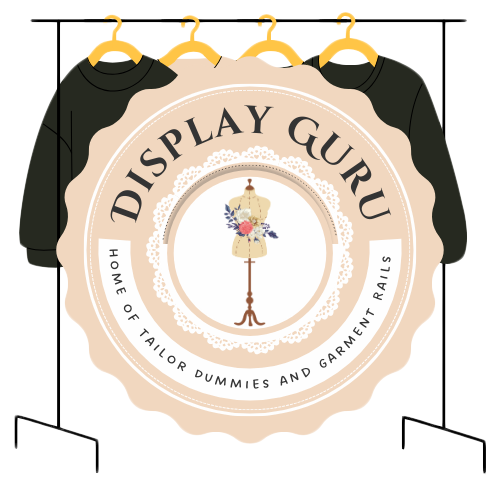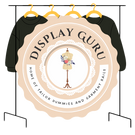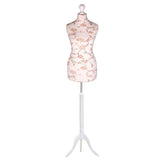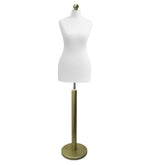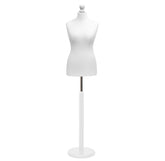Find Your Perfect Sewing Table with Storage
Picture this: a sewing space where every spool of thread, every bobbin, and every pair of scissors has its own home. That’s the reality a dedicated sewing table with storage can create. This isn't just about tidying up; it's about reclaiming your creative energy and focus.
From Creative Chaos to a Streamlined Workspace
A disorganised craft area is a familiar frustration for so many of us. You know the drill – hunting for that one specific colour of thread, untangling a bird's nest of bobbins from a messy drawer, or discovering your fabric patterns buried under a mountain of scraps. This kind of creative chaos can bring a project to a screeching halt, turning a relaxing hobby into a chore.
A sewing table with storage is designed to tackle these exact problems head-on. It’s far more than just a surface to work on; it's the command centre for your entire creative process. Think of it like the difference between cooking in a cluttered, messy kitchen and cooking in a well-organised one. When everything has its place, your workflow becomes smooth and almost effortless, letting you concentrate purely on your craft.
Reclaiming Your Creative Flow
A purpose-built sewing station brings a host of benefits that directly boost your productivity and, just as importantly, your enjoyment.
- Dedicated Storage: With integrated drawers, shelves, and clever compartments, your notions, tools, and fabrics are kept organised and always within arm’s reach.
- Reduced Clutter: By giving every item a home, it stops your workspace from becoming overwhelming, which can be a real mental drain.
- Enhanced Efficiency: When you spend less time searching for supplies, you have more time to actually sew. It's that simple. You'll find yourself finishing projects much faster.
This renewed focus on organised crafting couldn't be more timely. After a few years of decline, the UK's household sewing machine market saw a significant revival in 2024, growing by an impressive 13%. This points to a real surge in interest for DIY fashion and upcycling—activities that benefit massively from a properly structured workspace. For a deeper dive into this market resurgence, you can find more information on IndexBox.io.
A well-organised sewing table doesn't just store your supplies; it organises your thoughts. By eliminating clutter, you create the mental space needed for creativity to flourish, transforming your sewing sessions from frustrating to fulfilling.
Exploring the Different Types of Sewing Tables
Not all sewing tables are built the same. Think of them like kitchen worktops – some are little islands perfect for a quick snack, while others are sprawling counters designed for a full-scale banquet. The best sewing table with storage for you really comes down to your space, the kinds of projects you love, and your personal workflow.
It’s all about striking the right balance between functionality and footprint. If you’re sewing in a small flat, you’ll likely lean towards something that can be neatly tucked away. But if you have a dedicated craft room, you might go for a larger, more permanent station with all the bells and whistles. Let's walk through the most common styles to help you find your perfect match.
Compact and Concealable Tables
Working with limited space? A compact sewing table is a fantastic, space-saving solution. These are the transformers of the furniture world, often cleverly disguised as a stylish sideboard or a small desk when your machine is packed away. Their genius lies in their ability to fold down and shrink their footprint.
These tables often include:
- Drop-leaf extensions that give you that much-needed extra surface area for cutting or supporting fabric, then fold away neatly when you're done.
- Folding legs or collapsible frames, allowing the whole unit to be stored in a cupboard or flat against a wall.
- Integrated drawers and small cabinets that keep your essential threads, bobbins, and scissors tidy, even when the table is packed up.
Dedicated Sewing Cabinets
If sewing is your passion or profession, a dedicated sewing cabinet is a more robust, permanent home for your craft. These are generally larger and sturdier, designed to be the true heart of your sewing space. They offer far superior organisation and often come with clever features that make your sewing sessions more comfortable and efficient.
One of the most popular features in a quality sewing cabinet is the machine lift.
A machine lift is a special mechanism that lets you raise or lower your sewing machine to three key positions: stored away, tabletop height, and flat-bed. Quilters especially love the flat-bed position, as it makes the machine's base level with the table surface, creating a seamless, snag-free area to work on.
The image below gives a great visual of how different table designs, like those with drop-leaves or extra shelves, are built to suit various needs and room sizes.
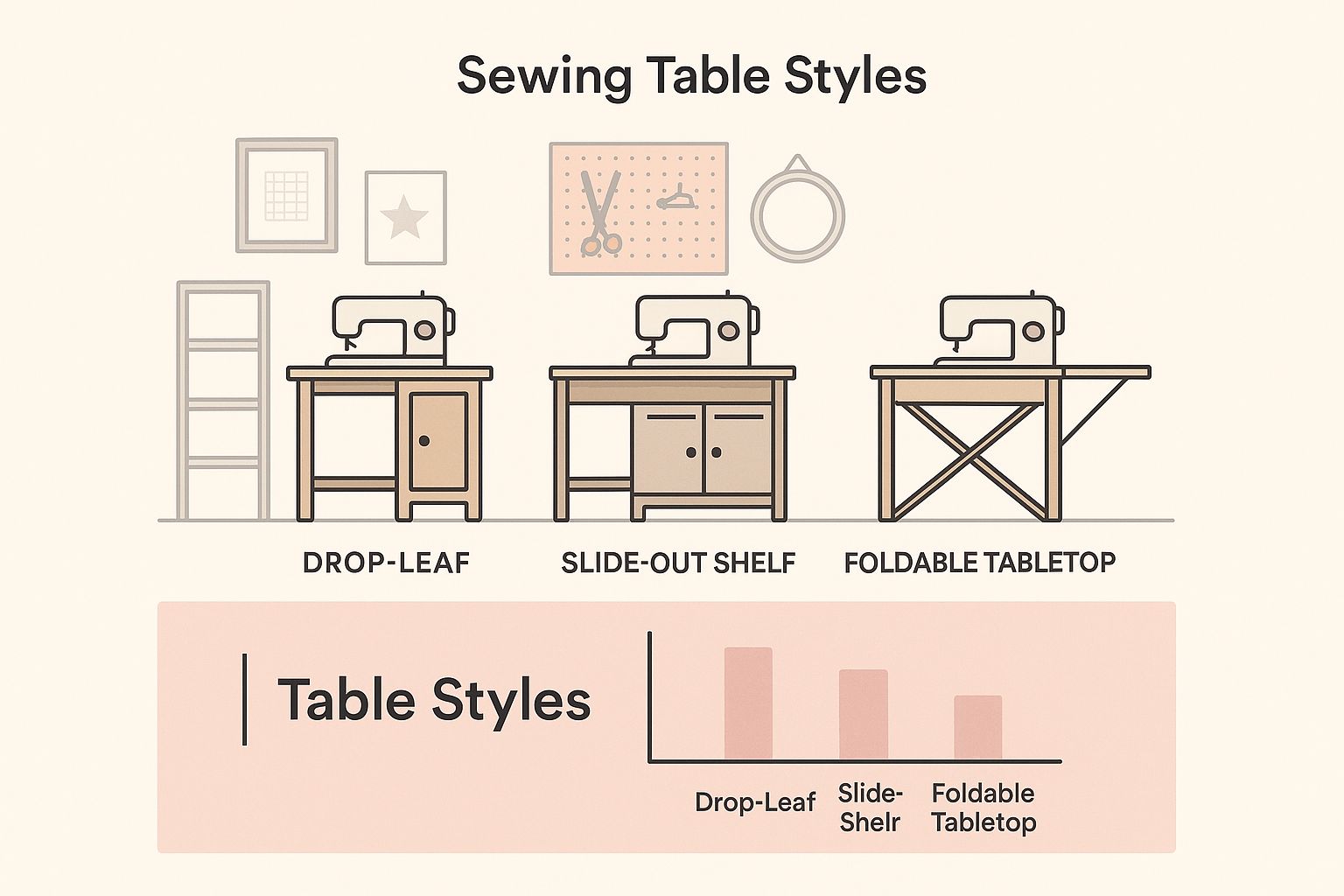
As you can see, the style you choose has a direct impact on your workflow and how you manage everything from your projects to your physical space.
To make things even clearer, let's compare these common styles side-by-side.
Comparing Sewing Table Styles
This table breaks down the key differences to help you decide which style best fits your space, project scope, and budget.
| Table Type | Best For | Key Storage Features | Footprint |
|---|---|---|---|
| Compact Table | Small flats, occasional sewists, multi-purpose rooms. | Small drawers, integrated cubbies, concealed shelving. | Small to very small (often foldable). |
| Sewing Cabinet | Dedicated hobbyists, quilters, those with a craft room. | Machine lift, deep drawers, thread racks, swing-out trays. | Medium to large (permanent fixture). |
| Workstation | Professionals, quilters, frequent pattern cutters. | Deep shelves for fabric bolts, wide drawers for patterns. | Large to very large (often standing height). |
Choosing the right table is about matching its features to your creative habits.
Large Workstations and Cutting Tables
For sewists who tackle big projects with large swathes of fabric, a combined sewing and cutting table is the ultimate command centre. These workstations give you a huge, uninterrupted surface that’s perfect for laying out and cutting patterns without everything shifting about.
Many of these models are also built to a comfortable standing height, which can be a real back-saver during those long cutting sessions. These tables typically come with extensive storage underneath, like deep shelves for fabric bolts and wide drawers for patterns and rulers. If this sounds like what you need, you can explore the advantages of a combined sewing and cutting table in our detailed guide.
Essential Features of a Great Sewing Table
So, what separates a merely good sewing table with storage from a truly great one? It’s not just about looks. It’s about a handful of key features that come together to make your time at the machine more productive, comfortable, and ultimately, more enjoyable. Think of it less as a simple piece of furniture and more like a dedicated workstation designed for your craft.
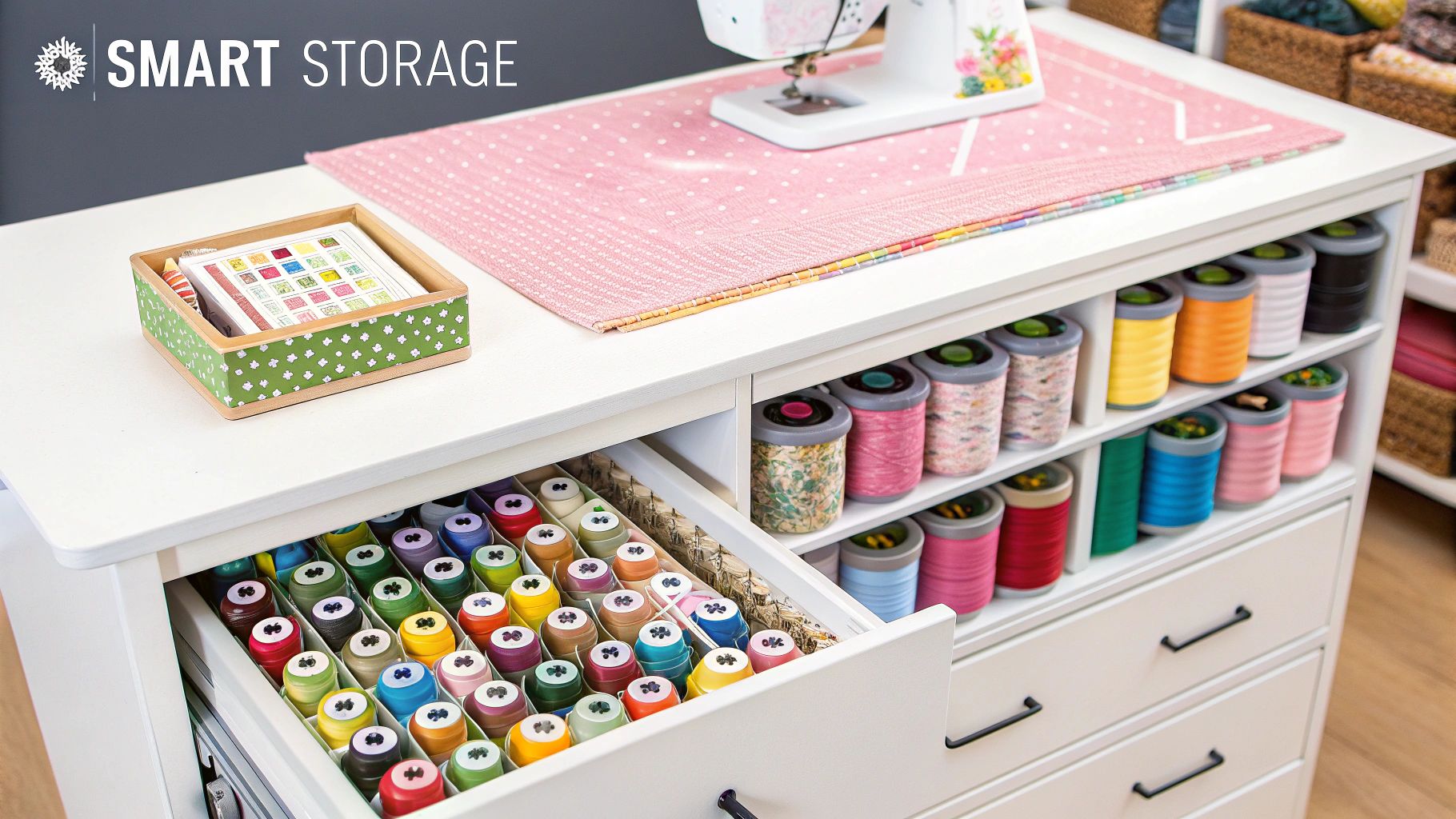
First and foremost, you need unwavering stability. When your sewing machine gets going, especially at top speed, it creates a surprising amount of vibration. A flimsy table will start to shake and rattle, which is more than just annoying—it can lead to skipped stitches, uneven seams, and a whole lot of frustration. A properly built sewing table has a solid, weighty frame designed to absorb those vibrations, giving you a completely still surface to work on.
Smart Design for Comfort and Precision
Beyond a solid foundation, thoughtful ergonomics are a must, particularly if you enjoy long sewing sessions. An adjustable machine lift is a perfect example of a feature that makes a world of difference. This mechanism lets you drop your sewing machine down so its sewing bed is perfectly level with the tabletop.
A flat-bed sewing position is an absolute game-changer. It creates one large, smooth surface, which stops your fabric from dragging or pulling over the edge of the machine. For anyone who's ever wrestled with a large quilt or yards of dress material, you know how much this helps. It eases the strain on your hands, back, and shoulders, letting you focus on your stitching.
The work surface itself also plays a huge role. You want a smooth, tough laminate that can stand up to the occasional scrape from scissors or pins. This ensures your fabric glides across the table without snagging, giving you far more control as you guide it.
Storage That Actually Works for You
Finally, let's talk about storage. It's not enough to just have a few drawers. The storage needs to be intelligent and designed with a sewer's needs in mind. The best tables offer clever solutions like:
- Deep drawers that are actually big enough to hold bolts of fabric or neatly folded patterns.
- Shallow, partitioned trays perfect for keeping small notions like bobbins, buttons, and needles from becoming a jumbled mess.
- Integrated thread racks or spool holders, so you can see all your colours at a glance and keep them tangle-free.
This kind of built-in organisation is what creates a seamless workflow. With the UK sewing thread market now valued at £147.4 million in 2024, it's clear that many of us are building up quite a collection! A well-designed table helps you manage all those supplies, keeping everything you need right where you need it. You can dive deeper into the sewing accessories market on Grandview Research.
For more tips on getting your creative space in order, our guide on sewing room storage ideas has some fantastic, practical advice that pairs perfectly with a great sewing table.
How to Choose the Right Table for You
So, how do you tie all this together and find your perfect match? Choosing the ideal sewing table with storage isn’t about picking the most expensive or feature-packed model on the market. It’s about finding the one that’s just right for you and your creative space. A little self-assessment now will ensure you end up with a piece of furniture you’ll genuinely love for years to come.
First things first: grab a tape measure. It sounds obvious, but it’s the most critical step. Measure the floor space you’ve earmarked for your new table, but don't stop there. Remember to account for the clearance you'll need to open drawers, extend drop-leaves, and pull your chair out comfortably. There’s no greater disappointment than getting your beautiful new table home only to find you can’t actually access half of its features.
Asking the Right Questions Before You Buy
Once you have your dimensions, it's time to think about how you actually work. Your personal sewing habits and the gear you use are just as important as the size of your room. Before you pull the trigger, run through this practical checklist:
- Machine Fit: What are the exact dimensions and weight of your sewing machine? You need to be certain the table can support it safely and that any recessed platform or well is the correct size.
- Chair Compatibility: Will your favourite sewing chair slide neatly underneath? Check the height clearance and legroom to avoid bruised knees and frustration.
- Surface Durability: Are you the kind of sewer who uses pins directly on the work surface? If so, a tough, scratch-resistant laminate top is non-negotiable.
- Project Scale: Do you tend to work on small, intricate garments, or are you a quilter who wrangles huge projects? Your answer will tell you how much extendable surface area you really need.
Think of it like being fitted for a bespoke suit. The aim is to find a table that fits your body, your machine, and your unique workflow perfectly. It’s about eliminating those little daily frustrations so your sewing time becomes a true pleasure.
Balancing Your Budget with Your Must-Have Features
Finally, let's talk money. It’s easy to get swept away by all the clever bells and whistles, so it’s wise to create a clear distinction between your 'must-haves' and your 'nice-to-haves'.
Perhaps a rock-solid, vibration-free surface is your top priority, but you could live without a fancy electronic machine lift for the time being. Or maybe you're desperate for drawer space to tame your fabric stash but don't need a massive cutting area. Likewise, while keeping finished projects organised is important, you could always add a portable clothing rack later on to keep initial costs down.
By creating this simple hierarchy, you can focus your search—and your budget—on the features that will make the biggest difference to your crafting. This thoughtful approach helps you select a sewing table that doesn't just organise your space, but genuinely enhances your creative process from the moment it arrives.
Setting Up Your New Sewing Command Centre
Bringing home a new sewing table with storage is a fantastic feeling. But the real joy starts when you set it up to be your personal creative hub. A smart setup isn't just about being tidy; it's about creating a smooth, efficient workflow that lets your creativity shine without constant interruptions. Think of it like a chef arranging their kitchen—everything has its place, right where you need it.
The first step is to create distinct zones. Even on a smaller table, you can dedicate specific areas for different parts of the sewing process. This simple act stops your tools from wandering off and creating a muddle.
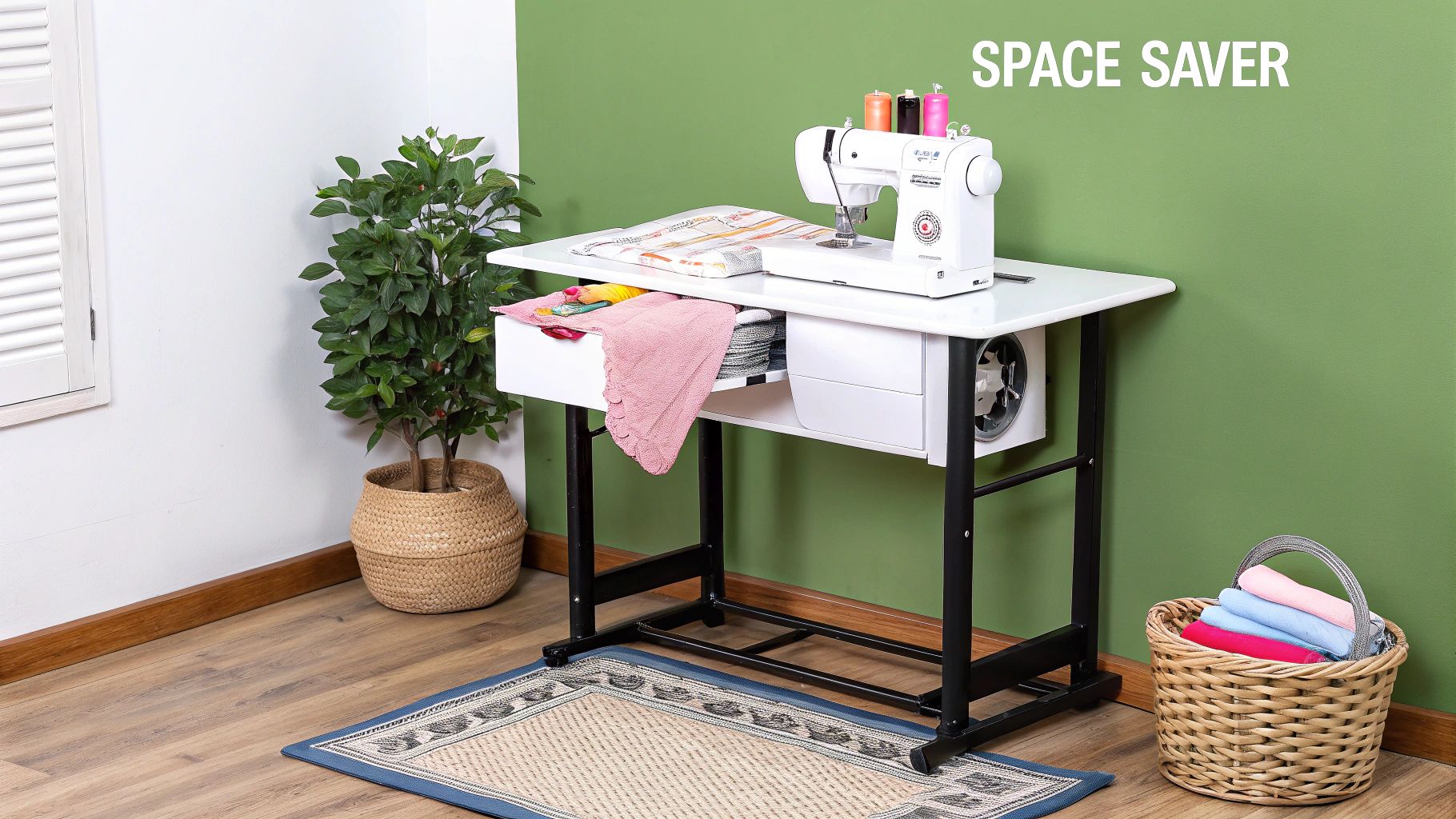
Organise by Workflow
The most sensible way to set up your space is to follow the natural flow of a sewing project. When you organise your table into zones, you create a seamless journey from fabric to finished piece. This mental map keeps you focused and cuts down on the time you waste hunting for the right tool.
- Cutting Zone: If your table features an extendable leaf, that’s your prime spot for cutting. Keep your rotary cutters, rulers, and cutting mat here. Tucking them into a nearby drawer means they're always ready for the next cut.
- Sewing Zone: This is the heart of your operation. Place your sewing machine where you have the best light and the most comfortable posture. The drawers and shelves closest to your chair should be reserved for your most-used items, like bobbins, common thread colours, and spare needles.
- Pressing Zone: For tables that don’t have a built-in heat-resistant surface, a small pressing mat and a mini-iron kept close by are a game-changer. It saves you from constantly hopping up to use the main ironing board for every little seam.
An organised sewing table is more than just tidy; it's a productivity system. By giving every tool a home, you eliminate decision fatigue and keep your mental energy focused on the creative work, not the logistical hunt for supplies.
Maximising Every Inch of Storage
The built-in storage is your secret weapon against clutter. You can make every drawer and shelf work harder with a few simple additions. Drawer dividers are brilliant for taming unruly notions like buttons, snaps, and seam rippers. I also love using small, clear containers for pins, clips, and machine feet, so I can see what I've got in a single glance.
Don’t neglect the vertical space. If your table has a pegboard back or open shelving, use it! It's the perfect spot for hanging scissors, rulers, and thread racks. This gets essential tools off your main work surface while keeping them within arm's reach. If you're looking for more inspiration, checking out other sewing room ideas can spark some really clever ways to arrange your new setup.
Understanding the UK Sewing Furniture Market
Thinking about buying a sewing table? It’s a real investment, so it helps to know a bit about the wider picture before you decide. A good sewing table with storage isn't just another piece of furniture; it's the very foundation of your craft space, supporting a hobby that continues to thrive across the UK. Seeing its value in today's market helps put your own purchase into perspective.
The demand for practical craft furniture often mirrors what’s happening with creative hobbies at home. When things like sewing, quilting, and upcycling are on the rise, it naturally affects the price and availability of the equipment we need. Knowing this helps you see your new table not as a simple expense, but as a long-term investment in your passion. After all, the right table becomes the heart of your creative world for years.
Market Trends and What They Mean for You
The market for sewing machine furniture here in the UK has been on a bit of a journey. After a strong growth spurt between 2017 and 2020, things have cooled off a little. In fact, figures from 2024 show the market has dipped by about 10.5%, settling at a value of roughly $47 million and marking the end of a three-year climb. You can dig into the numbers yourself with the latest insights from IndexBox.io.
So, what does that mean for you? A market shift like this can actually be good news for buyers. It often leads to more competitive prices or better deals as companies adjust their stock. It might just be the perfect moment to find fantastic value.
Understanding market fluctuations can empower your purchasing decisions. A slight dip in the market might mean it's the perfect time to invest in a higher-quality sewing table with storage that was previously just outside your budget, securing a better piece of equipment for less.
Ultimately, these tables are designed to solve a problem every crafter knows well: clutter and disorganisation. They’re an absolute game-changer, especially if you’re short on space. The right piece of furniture can turn a tight corner into a brilliantly organised and inspiring sewing station. If you're wrestling with a smaller area, our guide on small sewing space ideas has some fantastic, practical tips to help you make the most of every inch.
A Few Lingering Questions About Sewing Tables
Even with all the benefits laid out, you might still have some practical questions buzzing around your mind. That’s perfectly normal. Choosing the right sewing table with storage is a significant investment in your craft, and getting those last few details sorted can give you the confidence to make the right choice. Let's tackle some of the questions I hear most often.
Can't I Just Use a Regular Desk?
You absolutely can, but I wouldn't recommend it for the long run. A proper sewing table is engineered differently from your standard office desk. It’s built to be heavier and more stable, specifically to absorb the vibrations from your machine running at full tilt. This stability is what prevents skipped stitches and wobbly seams, giving you a much smoother sewing experience.
What's more, many dedicated tables come with a recessed platform. This lets you lower your machine so the sewing bed is flush with the tabletop, creating a flat-bed sewing surface. Trust me, your neck and shoulders will thank you, and guiding large pieces of fabric becomes a breeze.
A purpose-built sewing table is designed for the craft. Its stability and specialised features, like a machine lift and integrated storage for notions, create a workspace that actively supports your sewing process, unlike a generic office desk.
How Much Space Do I Realistically Need?
This is the big question, and the answer really depends on the model you’re eyeing up. Some of the compact, foldable cabinets are true marvels of design. They can shrink down to the size of a small side table, making them perfect if your sewing space doubles as a lounge or spare bedroom.
On the other end of the spectrum, you have the larger workstations that are designed to command a dedicated corner or even a whole wall in a craft room. Before you fall in love with a particular table, get out your tape measure. Always measure your available space, and then check the table’s dimensions for when it's fully open and when it’s folded away.
Is a Sewing Machine Lift Really Worth the Extra Cost?
For most sewists, I’d say a machine lift is an absolute game-changer. It’s one of those features you don’t think you need until you have it, and then you can't imagine living without it. This mechanism lets you move your machine from its storage position up to tabletop height or down into a flat-bed position, all without any heavy lifting.
It’s a lifesaver for your back, but it also massively improves your comfort and precision, especially during those long projects. If you’re a quilter, it’s practically essential for creating that perfectly level surface you need for piecing and free-motion work.
Ready to transform your creative space? The right tools make all the difference. Explore the high-quality, durable solutions at Display Guru and find the perfect foundation for your next project. Visit us at https://www.displayguru.co.uk to see our full range.
